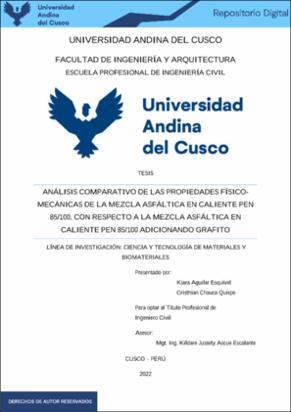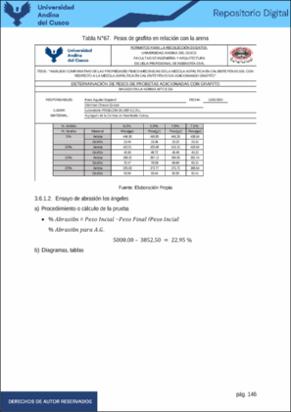| dc.contributor.advisor | Ascue Escalante, Kildare Jussety | |
| dc.contributor.author | Aguilar Esquivel, Kiara | |
| dc.contributor.author | Chauca Quispe, Cristhian | |
| dc.date.accessioned | 2022-12-22T20:50:25Z | |
| dc.date.available | 2022-12-22T20:50:25Z | |
| dc.date.issued | 2022-09-14 | |
| dc.identifier.uri | https://hdl.handle.net/20.500.12557/5051 | |
| dc.description.abstract | El objetivo de esta tesis es realizar un análisis comparativo de las propiedades físico –
mecánicas (Porcentaje de vacíos de aire, Cántabro, Estabilidad y Flujo Marshall, Daño Inducido
por Humedad), de una mezcla asfáltica en caliente PEN 85/100 en comparación con una mezcla
asfáltica en caliente PEN 85/100 adicionando grafito. Para la preparación de estos dos tipos de
mezclas bituminosas se utilizó el mismo nivel de clasificación o gradación y adicionándole
grafito con relación al peso del agregado fino; el agregado grueso ¾” fue obtenida de la cantera
de Huambutio (Lucre), para el agregado grueso de ½” y agregado fino se usó material de la
Planta de Asfalto Caicay COPESCO. Este análisis se realiza utilizando parámetros
volumétricos, cuyo objetivo es determinar el porcentaje óptimo de asfalto para una combinación
particular de agregados para hacer muestras de mezcla asfáltica en caliente, las mismas incluyen
diferentes porcentajes de asfalto (6.0%, 6.5%, 7.0%, 7.5%), obteniendo el 6.5% de asfalto
óptimo, para luego preparar especímenes que fueron adicionados con distintos porcentajes de
grafito (5%, 10%, 15% y 20 %) con relación al peso del agregado fino, obteniendo así 15% de
grafito óptimo. Todas las muestras han sido ensayadas en laboratorio para determinar sus
propiedades mecánicas tales como parámetros volumétricos, estabilidad Marshall y flujo,
cántabro y daño inducido por humedad. Además, en base a estos resultados y a lo establecido
en el manual de Carreteras “Especificaciones Generales para la Construcción EG – 2013” del
Ministerio de Transporte del Perú, es posible comparar las propiedades físico-mecánicas de las
normas que se han estudiado, se llega a la conclusión que en la mayoría de las propiedades
físico mecánicas de las mezclas asfálticas adicionadas con grafito no tienen mejores resultados
ni son similares para cada tipo de ensayo como se muestra en la Tabla N°98 (pág. 187), y
teniendo como únicos valores más similares el ensayo de cántabro, obteniendo como resultados
para mezclas asfálticas sin grafito un % desgaste = 4.53% y mezclas asfálticas con grafito un
% desgaste = 4.68%. Así mismo, se tiene en consideración que los valores de % VCAmezcla sin
grafito y con grafito son 56.51% y 56.21% respectivamente, estos valores se aproximan entre
ellos y son menores al valor de VCADRC = 56.60%; no obstante, la mezcla asfáltica con grafito
es mejor. Como los resultados de las mezclas asfálticas adicionadas con grafito no se asemejan
ni cumplen a los resultados de mezclas asfálticas PEN 85/100 por lo que fruto de la presente
investigación no se recomienda el uso de grafito como un agente estabilizante para las mezclas
asfálticas en caliente PEN 85/100. | es_PE |
| dc.description.abstract | The objective of this thesis is to perform a comparative analysis of the physical - mechanical
properties (Percentage of air voids, Cantabrian, Stability and Marshall Flow, Moisture-Induced
Damage), of a hot asphalt mixture PEN 85/100, compared to a hot asphalt mixture PEN 85/100
adding graphite. For the preparation of these two types of bituminous mixtures, the same level
of classification or gradation was used and graphite was added in relation to the weight of the
fine aggregate; the 3/4" coarse aggregate was obtained from the Huambutio (Lucre) quarry, for
the 1/2" coarse aggregate and fine aggregate material from the Caicay COPESCO Asphalt Plant
was used. This analysis is performed using volumetric parameters, whose objective is to
determine the optimal percentage of asphalt for a particular combination of aggregates to make
samples of hot asphalt mixture, they include different percentages of asphalt (6.0%, 6.5%, 7.0%,
7.5%), obtaining 6.5% of optimal asphalt, and then prepare specimens that were added with
different percentages of graphite (5%, 10%, 15% and 20%) in relation to the weight of the fine
aggregate, thus obtaining 15% of optimal graphite. All samples have been tested in the
laboratory to determine their mechanical properties such as volumetric parameters, Marshall
stability and flow, Cantabrian and moisture-induced damage. In addition, based on these results
and the provisions of the Road Manual "General Specifications for Construction EG – 2013"
of the Ministry of Transport of Peru, it is possible to compare the physical-mechanical
properties of the standards that have been studied, it is concluded that in most of the physical
mechanical properties of the asphalt mixtures added with graphite do not have better results or
are similar for each type of test as is shown in Table N°98 (p. 187), and having as the only more
similar values the Cantabrian test, obtaining as results for asphalt mixtures without graphite a
% wear = 4.53% and asphalt mixtures with graphite a % wear = 4.68%. Likewise, it is taken
into consideration that the values of % VCAmezcla without graphite and with graphite are 56.51%
and 56.21% respectively, these values approximate each other and are lower than the value of
VCADRC = 56.60%; however, asphalt mixing with graphite is better. As the results of the asphalt
mixtures added with graphite do not resemble or comply with the results of PEN 85/100 asphalt
mixtures, so as a result of this research the use of graphite as a stabilizing agent for PEN 85/100
hot asphalt mixtures is not recommended. | en_US |
| dc.format | application/pdf | es_PE |
| dc.language.iso | spa | es_PE |
| dc.publisher | Universidad Andina del Cusco | es_PE |
| dc.rights | info:eu-repo/semantics/openAccess | es_PE |
| dc.rights.uri | https://creativecommons.org/licenses/by-nc-nd/4.0/ | es_PE |
| dc.subject | Grafito | es_PE |
| dc.subject | Estabilidad y flujo | es_PE |
| dc.subject | Cántabro | es_PE |
| dc.subject | Daño Inducido por humedad | es_PE |
| dc.title | Análisis comparativo de las propiedades físicomecánicas de la mezcla asfáltica en caliente pen 85/100, con respecto a la mezcla asfáltica en caliente pen 85/100 adicionando grafito | es_PE |
| dc.type | info:eu-repo/semantics/bachelorThesis | es_PE |
| thesis.degree.name | Ingeniero Civil | es_PE |
| thesis.degree.grantor | Universidad Andina del Cusco. Facultad de Ingeniería y Arquitectura | es_PE |
| thesis.degree.discipline | Ingeniería Civil | es_PE |
| dc.publisher.country | PE | es_PE |
| dc.subject.ocde | https://purl.org/pe-repo/ocde/ford#2.01.01 | es_PE |
| renati.advisor.dni | 45246758 | |
| renati.advisor.orcid | https://orcid.org/0000-0003-1309-4280 | es_PE |
| renati.author.dni | 47069445 | |
| renati.author.dni | 70412316 | |
| renati.discipline | 732016 | es_PE |
| renati.juror | Roman Villegas, Eigner | |
| renati.juror | Gutierrez Vallejo, Heber Darwin | |
| renati.juror | Chipana Molina, Yimmy | |
| renati.juror | Nuñez Del Prado Coll, Enrique | |
| renati.level | https://purl.org/pe-repo/renati/level#tituloProfesional | es_PE |
| renati.type | https://purl.org/pe-repo/renati/type#tesis | es_PE |
| dc.description.lineadeinvestigacion | Ciencia y tecnología de materiales y biomateriales | es_PE |



